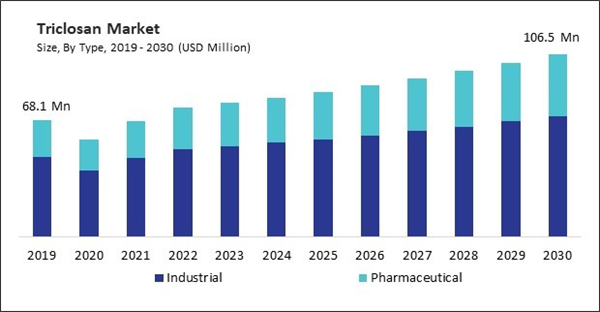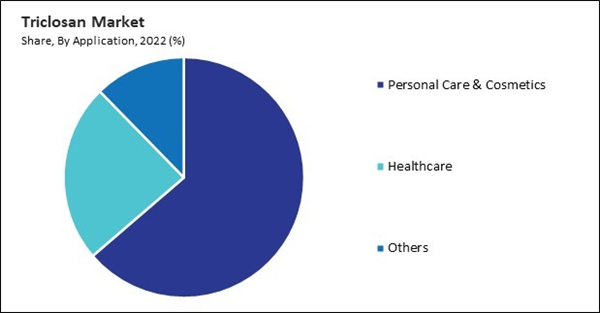The Global Triclosan Market size is expected to reach $106.5 Million by 2030, rising at a market growth of 4.5% CAGR during the forecast period. In the year 2022, the market attained a volume of 5,077.1 Tonnes, experiencing a growth of 3.7% (2019-2022).
The Asia Pacific region is witnessing rapid urbanization, rising disposable incomes, and changing lifestyles, leading to increased spending on personal care products. Therefore, the Asia Pacific region captured $30.9 million revenue in the market in 2022. The expanding healthcare infrastructure in countries across the Asia Pacific region drives its demand in healthcare settings.
Foodborne illnesses pose significant public health risks and can result in severe health consequences, including hospitalization and even death. As a result, there is heightened awareness and concern among consumers, regulatory agencies, and food manufacturers regarding food safety. Therefore, the market is expanding significantly due to the growing prevalence of foodborne illnesses.
Additionally, triclosan is extensively used in veterinary healthcare products to promote animal health and prevent infections. Veterinary clinics, animal hospitals, and livestock farms utilize such products such as wound cleansers, antiseptic solutions, and oral care formulations to treat wounds, prevent infections, and maintain animal hygiene. Thus, because of the expansion of the animal health industry, the market is anticipated to increase significantly.
However, regulatory authorities require safety assessments and toxicological studies to examine the potential health effects of its exposure. These assessments may involve reviewing scientific data on it’s toxicity, carcinogenicity, reproductive effects, and endocrine-disrupting properties. Thus, regulatory restrictions can slow down the growth of the market.
The Asia Pacific region is witnessing rapid urbanization, rising disposable incomes, and changing lifestyles, leading to increased spending on personal care products. Therefore, the Asia Pacific region captured $30.9 million revenue in the market in 2022. The expanding healthcare infrastructure in countries across the Asia Pacific region drives its demand in healthcare settings.
Foodborne illnesses pose significant public health risks and can result in severe health consequences, including hospitalization and even death. As a result, there is heightened awareness and concern among consumers, regulatory agencies, and food manufacturers regarding food safety. Therefore, the market is expanding significantly due to the growing prevalence of foodborne illnesses.
Additionally, triclosan is extensively used in veterinary healthcare products to promote animal health and prevent infections. Veterinary clinics, animal hospitals, and livestock farms utilize such products such as wound cleansers, antiseptic solutions, and oral care formulations to treat wounds, prevent infections, and maintain animal hygiene. Thus, because of the expansion of the animal health industry, the market is anticipated to increase significantly.
However, regulatory authorities require safety assessments and toxicological studies to examine the potential health effects of its exposure. These assessments may involve reviewing scientific data on it’s toxicity, carcinogenicity, reproductive effects, and endocrine-disrupting properties. Thus, regulatory restrictions can slow down the growth of the market.
By Application Analysis
Based on application, the market is classified into personal care & cosmetics, healthcare, and others. In 2022, the personal care & cosmetics segment witnessed 63.7% revenue share in the market. This prevents the growth of germs that cause odour on the skin and is used in deodorants and antiperspirants.By Type Analysis
By type, the market is categorized into industrial and pharmaceutical. The pharmaceutical segment covered 31.9% revenue share in the market in 2022. This is incorporated into wound care products such as antiseptic creams, ointments, and wound dressings to prevent infections and promote wound healing.By Regional Analysis
Region-wise, the market is analysed across North America, Europe, Asia Pacific, and LAMEA. In 2022, the North America region acquired 24.7% revenue share in the market. North America has witnessed a growing demand for antimicrobial products among consumers seeking enhanced hygiene and protection against pathogens.List of Key Companies Profiled
- BASF SE
- Cayman Chemical Company, Inc.
- Merck KGaA
- Spectrum Chemical Mfg. Corp (Spectrum Laboratory Products, Inc.)
- Jiangsu Huanxin High-tech Materials Co., Ltd.
- R A Dyestuffs India Private Limited
- Kumar Organic Products Limited
- Dev Impex
- Salicylates and Chemicals Private Limited
- Shandong Aoyou Biological Technology Co. Ltd
Market Report Segmentation
By Type (Volume, Tonnes, USD Billion, 2019-2030)- Industrial
- Pharmaceutical
- Personal Care & Cosmetics
- Healthcare
- Others
- North America
- US
- Canada
- Mexico
- Rest of North America
- Europe
- Germany
- UK
- France
- Russia
- Spain
- Italy
- Rest of Europe
- Asia Pacific
- China
- Japan
- India
- South Korea
- Singapore
- Malaysia
- Rest of Asia Pacific
- LAMEA
- Brazil
- Argentina
- UAE
- Saudi Arabia
- South Africa
- Nigeria
- Rest of LAMEA
Table of Contents
Chapter 1. Market Scope & Methodology
Chapter 2. Market at a Glance
Chapter 3. Market Overview
Chapter 4. Global Triclosan Market, By Type
Chapter 5. Global Triclosan Market, By Application
Chapter 6. Global Triclosan Market, By Region
Chapter 7. Company Profiles
Companies Mentioned
- BASF SE
- Cayman Chemical Company, Inc.
- Merck KGaA
- Spectrum Chemical Mfg. Corp (Spectrum Laboratory Products, Inc.)
- Jiangsu Huanxin High-tech Materials Co., Ltd.
- R A Dyestuffs India Private Limited
- Kumar Organic Products Limited
- Dev Impex
- Salicylates and Chemicals Private Limited
- Shandong Aoyou Biological Technology Co. Ltd
Methodology

LOADING...










